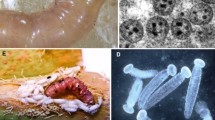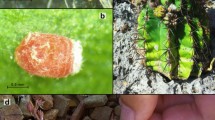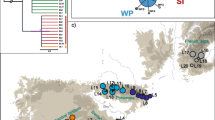Abstract
How communities of natural enemies, such as parasitoids, adapt to the range expansion of their hosts or the arrival of a novel invasive host is an important question in invasion biology. Do parasitoids track the expansion of their hosts from their shared native range? Do they locally adapt both behaviorally and physiologically to the arrival of a novel species by shifting hosts? Few studies have addressed those questions, yet they are important to develop efficient methods to manage invasive species. Here we focus on Pnigalio mediterraneus Ferriére and Delucchi (Hymenoptera: Eulophidae), an important parasitoid of two major agricultural and ornamental pests, the olive fruit fly Bactrocera oleae Rossi (Diptera: Tephritidae) and the horse chestnut leafminer Cameraria ohridella Deschka & Dimic (Lepidoptera: Gracillariidae). C. ohridella recently invaded Europe starting from the Southern Balkans, whereas B. oleae has been associated since the Quaternary with wild olives in the Mediterranean, where it largely spread after the domestication of cultivated olives. We used two markers, the ribosomal spacer ITS2 and the mitochondrial gene COI. Although the ITS2 dataset provided little variation and no phylogeographic signal, analysis of mtDNA of 188 individuals of P. mediterraneus from 54 European localities allowed us to identify 53 haplotypes. Both nucleotide and haplotype diversity were higher for Mediterranean samples, and from samples reared from B. oleae. The statistical parsimony network identified one haplotype as the most frequent, ancestral and mainly associated with C. ohridella. Our findings suggest that P. mediterraneus locally host switched to C. ohridella from other hosts in the Balkans and later tracked the horse chestnut leafminer invasion over Europe. Therefore both host-tracking and ecological sorting could explain the current distribution of P. mediterraneus haplotypes.



Similar content being viewed by others
References
Askew RR (1984) Species of Pnigalio and Chrysocharis (Hymenoptera: Eulophidae) parasitic on Tischeriidae (Lepidoptera), with the description of a new species. Entomol Gaz 35:103–109
Augustin S, Guichard S, Heitland W, Freise J, Svatos A, Gilbert M (2009) Monitoring and dispersal of the invading Gracillariidae Cameraria ohridella. J Appl Entomol 133:58–66
Avise J (1998) The history and purview of phylogeography: a personal reflection. Mol Ecol 7:371–379
Avise J (2009) Phylogeography: retrospect and prospect. J Biogeogr 36:3–15
Baer CF, Tripp DW, Bjorksten TA, Antolin MF (2004) Phylogeography of a parasitoid wasp (Diaeretiella rapae): no evidence of host-associated lineages. Mol Ecol 13:1859–1869
Beaumont MA, Panchal M (2008) On the validity of nested clade phylogeographical analysis. Mol Ecol 17:2563–2565
Bernardo U, Monti MM, Nappo AG, Gebiola M, Russo A, Pedata P, Viggiani G. (2008) Species status of two populations of Pnigalio soemius (Hymenoptera: Eulophidae) reared from two different hosts: An integrative approach. Biol Control 46:293–303
Bronzini de Caraffa V, Giannettini J, Gambotti C, Maury J (2002) Genetic relationships between cultivated and wild olives of Corsica and Sardinia using RAPD markers. Euphytica 123:263–271
Brower AV (1994) Rapid morphological radiation and convergence among races of the butterfly Heliconius erato inferred from patterns of mitochondrial DNA evolution. PNAS 91:6491–6495
Campbell BC, Steffen-Campbell JD, Werren JH (1993) Phylogeny of the Nasonia species complex (Hymenoptera: Pteromalidae) inferred from an internal transcribed spacer (ITS2) and 28S rDNA sequences. Insect Mol Biol 2:225–237
Chao A (1984) Nonparametric estimation of the number of classes in a population. Scand J Stat 11:265–270
Chesters D, Wang Y, Yu F, Bai M, Zhang T-X, Hu H-Y, Zhu C-D, Li C-D, Zhang Y-Z (2012) The integrative taxonomic approach reveals host specific species in an encyrtid parasitoid species complex. PLoS One 7:e37655
Clement M, Posada D, Crandall KA (2000) TCS: a computer program to estimate gene genealogies. Mol Ecol 9:1657–1659
Colwell RK, Coddington JA (1994) Estimating terrestrial biodiversity through extrapolation. Philos Trans R Soc Lond Ser B 345:101–118
Diamantidis A, Carey J (2011) Ancestral populations perform better in a novel environment: domestication of Mediterranean fruit fly populations from five global regions. Biol J Linn Soc 102:334–345
Excoffier L, Lischer HEL (2010) Arlequin suite ver 3.5: a new series of programs to perform population genetics analyses under Linux and Windows. Mol Ecol Resour 10:564–567
Ferrière C, Delucchi V (1957) Les hyménoptères parasites de la mouche des olives. I. Les chalcidiens de la région méditerranéenne. Entomophaga 2:119–128
Ferracini C, Alma A (2007) Evaluation of the community of native eulophid parasitoids on Cameraria ohridella Deschka and Dimic in urban areas. Environ Entomol 36:1147–1153
Ferreira M, Ferguson J (2010) Do Mediterranean crickets Gryllus bimaculatus De Geer (Orthoptera: Gryllidae) come from the Mediterranean? Largescale phylogeography and regional gene flow. Bull Entomol Res 100:49–58
Freise J, Heitland W, Tosevski I (2002) Parasitism of the horse chestnut leaf miner, Cameraria ohridella Deschka and Dimic (Lep., Gracillariidae), in Serbia and Macedonia. J Pest Sci 75:152–157
Gebiola M, Bernardo U, Monti MM, Navone P, Viggiani G (2009) Pnigalio agraules (Walker) and Pnigalio mediterraneus Ferrière and Delucchi (Hymenoptera: Eulophidae): two closely related valid species. J Nat Hist 43:2465–2480
Gebiola M, Bernardo U, Burks RA (2010) A reevaluation of the generic limits of Pnigalio Schrank (Hymenoptera: Eulophidae) based on molecular and morphological evidence. Zootaxa 2484:35–44
Gebiola M, Gómez-Zurita J, Monti MM, Navone P, Bernardo U (2012) Integration of molecular, ecological, morphological and endosymbiont data for species delimitation within the Pnigalio soemius complex (Hymenoptera: Eulophidae). Mol Ecol 21:1190–1208
Girardoz S, Quicke D, Kenis M (2007) Factors favouring the development and maintenance of outbreaks in an invasive leaf miner Cameraria ohridella (Lepidoptera: Gracillariidae): a life table study. Agric For Entomol 9:141–158
Grabenweger G (2003) Parasitism of different larval stages of Cameraria ohridella. Biocontrol 48:671–684
Grabenweger G, Lethmayer C (1999) Occurrence and phenology of parasitic Chalcidoidea on the horse chestnut leafminer, Cameraria ohridella Deschka & Dimic (Lep., Gracillariidae). J Appl Entomol 123:257–260
Grabenweger G, Avtzis N, Girardoz S, Hrasovec B, Tomov R, Kenis M (2005) Parasitism of Cameraria ohridella (Lepidoptera, Gracillariidae) in natural and artificial horse-chestnut stands in the Balkans. Agric For Entomol 7:291–296
Grabenweger G, Hopp H, Jaeckel B, Balder H, Koch T, Schmolling S (2007) Impact of poor host-parasitoid synchronisation on the parasitism of Cameraria ohridella (Lepidoptera: Gracillariidae). Eur J Entomol 104:153–158
Grabenweger G, Kehrli P, Zweimüller I, Augustin S, Avtzis N, Bacher S, Freise J, Girardoz S, Guichard S, Heitland W, Lethmayer C, Stolz M, Tomov R, Volter L, Kenis M (2010) Temporal and spatial variations in the parasitoid complex of the horse chestnut leafminer during its invasion of Europe. Biol Invasions 12:2797–2813
Hall TA (1999) BioEdit: a user-friendly biological sequence alignment editor and analysis program for Windows 95/98/NT. Nucleic Acids Symp Ser 41:95–98
Harpending HC (1994) Signature of ancient population growth in a low-resolution mitochondrial DNA mismatch distribution. Hum Biol 66:591–600
Hayward A, Stone GN (2006) Comparative phylogeography across two trophic levels: the oak gall wasp Andricus kollari and its chalcid parasitoid Megastigmus stigmatizans. Mol Ecol 15:479–489
Hernandez-Lopez A, Rougerie R, Augustin S, Lees DC, Tomov R, Kenis M, Çota E, Kullaj E, Hansson C, Grabenweger G, Roques A, Lopez-Vaamonde C (2012) Host tracking or cryptic adaptation? Phylogeography of Pediobius saulius (Hymenoptera, Eulophidae), a parasitoid of the highly invasive horse-chestnut leafminer. Evol Appl 5:256–269
Hewitt GM (2001) Speciation, hybrid zones and phylogeography—or seeing genes in space and time. Mol Ecol 10:537–549
Janz N (2011) Ehrlich and Raven revisited: mechanisms underlying codiversification of plants and enemies. Annu Rev Ecol Evol Syst 42:71–89
Kalinowski ST (2004) Counting alleles with rarefaction: private alleles and hierarchical sampling designs. Conserv Genet 5:539–543
Katoh K, Toh H (2008) Recent developments in the MAFFT multiple sequence alignment program. Br Bioinform 9:286–298
Keane RM, Crawley MJ (2002) Exotic plant invasions and the enemy release hypothesis. Trends Ecol Evol 17:164–170
Klug T, Meyhofer R, Kreye M, Hommes M (2008) Native parasitoids and their potential to control the invasive leafminer, Cameraria ohridella DESCH. & DIM. (Lep.: Gracillariidae). Bull Entomol Res 98:379–387
Lawson Handley LJ, Estoup A, Evans D, Thomas C, Lombaert E, Facon B, Aebi A, Roy HE (2011) Ecological genetics of invasive alien species. Biocontrol 56:409–428
Lees DC, Lack HW, Rougerie R, Hernandez-Lopez A, Raus T, Avtzis ND, Augustin S, Lopez-Vaamonde C (2011) Tracking origins of invasive herbivores through herbaria and archival DNA: the case of the horse-chestnut leaf miner. Front Ecol Environ 9:322–328
Li Y, Zhou X, Feng G, Hu H, Niu L, Hebert P, Huang D (2010) COI and ITS2 sequences delimit species, reveal cryptic taxa and host specificity of fig-associated Sycophila (Hymenoptera, Eurytomidae). Mol Ecol Res 10:31–40
Librado P, Rozas J (2009) DnaSP v5: a software for comprehensive analysis of DNA polymorphism data. Bioinformatics 25:451–1452
Loxdale H (2010) Rapid genetic changes in natural insect populations. Ecol Entomol 35:155–164
Lozier JD, Roderick GK, Mills NJ (2008) Evolutionarily significant units in natural enemies: identifying regional populations of Aphidius transcaspicus (Hymenoptera: Braconidae) for use in biological control of mealy plum aphid. Biol Control 46:532–541
Lozier JD, Roderick GK, Mills NJ (2009) Molecular markers reveal geographic, but not host associated, genetic differentiation in the aphid parasitoid Aphidius transcaspicus a parasitoid of the aphid genus Hyalopterus. Bull Entomol Res 99:83–96
Lupi D (2005) A 3 year field survey of the natural enemies of the horse-chestnut leaf miner Cameraria ohridella in Lombardy, Italy. Biocontrol 50:113–126
Menendez R, Gonzalez-Megias A, Lewis OT, Shaw MR, Thomas CD (2008) Escape from natural enemies during climate-driven range expansion: a case study. Ecol Entomol 33:413–421
Mey W (1993) Zur Parasitierung der Pfennigminiermotte, Leucoptera malifoliella (Costa),(Lep., Lyonetiidae) im Havelländischen Obstbaugebiet. J Appl Entomol 115:329–341
Nardi F, Carapelli A, Dallai R, Roderick GK, Frati F (2005) Population structure and colonization history of the olive fly, Bactrocera oleae (Diptera, Tephritidae). Mol Ecol 14:2729–2738
Nardi F, Carapelli A, Boore JL, Roderick GK, Dallai R, Frati F (2010) Domestication of olive fly through a multi-regional host shift to cultivated olives: comparative dating using complete mitochondrial genomes. Mol Phylogenet Evol 57:678–686
Nicholls JA, Fuentes-Utrilla P, Hayward A, Melika G, Csóka G, Nieves-Aldrey J-L, Pujade-Villar J, Tavakoli M, Schonrogge K, Stone GN (2010) Community impacts of anthropogenic disturbance: natural enemies exploit multiple routes in pursuit of invading herbivore hosts. BMC Evol Biol 10:322
Noyes JS (2012) Universal chalcidoidea database. Available from: http://www.nhm.ac.uk/research-curation/projects/chalcidoids/database/index.dsmlresearch/
Panchal M (2007) The automation of nested clade phylogeographic analysis. Bioinf 23:509
Pauls SU, Lumbsch HT, Haase P (2006) Phylogeography of the montane caddisfly Drusus discolour: evidence for multiple refugia and perglacial survival. Mol Ecol 15:2153–2169
Phillips BL, Kelehear C, Pizzatto L, Brown GP, Barton D, Shine R (2010) Parasites and pathogens lag behind their host during periods of host range advance. Ecology 91:872–881
Quacchia A, Ferracini C, Nicholls JA, Piazza E, Saladini MA, Tota F, Melika G, Alma A (2013) Chalcid parasitoid community associated with the invading pest Dryocosmus kuriphilus in north-western Italy. Insect Conserv Divers 6:114–123
Rogers AR (1995) Genetic evidence for a Pleistocene population explosion. Evolution 49:608–615
Rogers AR, Harpending H (1992) Population growth makes waves in the distribution of pairwise genetic differences. Mol Biol Evol 9:552–569
Roques A, Rabitsch W, Rasplus JY, Lopez-Vaamonde C, Nentwig W, Kenis M (2008) Alien terrestrial invertebrates of Europe. In: Nentwig W, Hulme P, Pysek P, Vila M (eds) Handbook of alien species in Europe. Springer, Berlin, pp 63–79
Rousselet J, Zhao R, Argal D, Simonato M, Battisti A, Roques A, Kerdelhué C (2010) The role of topography in structuring the demographic history of the pine processionary moth, Thaumetopoea pityocampa (Lepidoptera: Notodontidae). J Biogeogr 37:1478–1490
Roy HE, Lawson Handley LJ, Schonrogge K, Poland RL, Purse BV (2011) Can the enemy release hypothesis explain the success of invasive alien predators and parasitoids? Biocontrol 56:451–468
Rugman-Jones P, Wharton R, Noort T, Stouthamer R (2009) Molecular differentiation of the Psyttalia concolor (Szépligeti) species complex (Hymenoptera: Braconidae) associated with olive fly, Bactrocera oleae (Rossi) (Diptera: Tephritidae), in Africa. Biol Control 49:17–26
Schulmeister S (2003) Simultaneous analysis of basal Hymenoptera (Insecta): introducing robust-choice sensitivity analysis. Bot J Linn Soc 79:245–275
Simon C, Frati F, Beckenbach A, Crespi B, Liu H, Flook P (1994) Evolution, weighting, and phylogenetic utility of mitochondrial gene sequences and a compilation of conserved polymerase chain reaction primers. Ann Entomol Soc Am 87:651–701
Slatkin M (1993) Isolation by distance in equilibrium and non-equilibrium populations. Evolution 47:264–279
Stone GN, Lohse K, Nicholls JA, Fuentes-Utrilla P, Sinclair F, Schönrogge K, Csoka G, Melika G, Nieves-Aldrey J-L, Pujade-Villar J, Tavakoli M, Askew RR, Hickerson J (2012) Reconstructing community assembly in time and space reveals enemy escape in a western Palearctic insect community. Curr Biol 22:532–537
Stouthamer R, Hu JG, van Kan F, Platner GR, Pinto JD (1999) The utility of internally transcribed spacer 2 DNA sequences of the nuclear ribosomal gene for distinguishing sibling species of Trichogramma. Biocontrol 43:421–440
Templeton AR, Crandall KA, Sing CF (1992) A cladistic analysis of phenotypic associations with haplotypes inferred from restriction endonuclease mapping and DNA sequence data. III. Cladogram estimation. Genetics 132:619–633
Templeton A, Routman E, Phillips C (1995) Separating population structure from population history: a cladistic analysis of the geographical distribution of mitochondrial DNA haplotypes in the tiger salamander, Ambystoma tigrinum. Genetics 140:767
Tsai Y-HE (2010) PhyloGeoViz: a web-based program that visualizes genetic data on maps. Mol Ecol Res 11:557–561
Valade R, Kenis M, Hernandez-Lopez A, Augustin S, Mena N, Magnoux E, Rougerie R, Lakatos F, Roques A, Lopez-Vaamonde C (2009) Mitochondrial and microsatellite DNA markers reveal a Balkan origin for the highly invasive horse-chestnut leaf miner Cameraria ohridella (Lepidoptera, Gracillariidae). Mol Ecol 18:3458–3470
Volter L, Kenis M (2006) Parasitoid complex and parasitism rates of the horse chestnut leafminer, Cameraria ohridella (Lepidoptera: Gracillariidae) in the Czech Republic, Slovakia and Slovenia. Eur J Entomol 103:365–370
Welch JJ, Bromham L (2005) Molecular dating when rates vary. Trends Ecol Evol 20:320–327
Xiang Q, Crawford D, Wolfe A, Tang Y (1998) Origin and biogeography of Aesculus L. (Hippocastanaceae): a molecular phylogenetic perspective. Evolution 52:988–997
Zappalà L, Bernardo U, Biondi A, Cocco A, Deliperi S, Delrio G, Giorgini M, Pedata PA, Rapisarda C, Tropea Garzia G, Siscaro G (2012) Recruitment of native parasitoids by the exotic pest Tuta absoluta in Southern Italy. Bull Insectol 65:51–61
Acknowledgments
Authors thank Prof. Lionel Andriescu, Sylvie Augustin, Luigi Boccaccio, Salvatore Deliperi, Annalisa Di Luca, Ferran Garcia-Marì, Massimo Giorgini, Gisheler Grabenweger, Mark Kenis, Cedomir Markovic, Giustiniano Matteucig, Rainer Meyhöfer, Paolo Navone, Paolo Pedata, Christelle Péré, Andrew Polaszek, Nicolas Ris, Maria Concetta Rizzo, Raffaele Sasso, Rumen Tomov for providing samples for this study. Thanks to Antonio Hernandez-Lopez and David Lees for comments on an earlier version. This work was partly supported by a CNR Short Term Mobility Fellowship (year 2011) accorded to C. Lopez-Vaamonde, by the ATARTIB project with University of Forestry, Sofia, Bulgaria, and by the project: “Insects and globalization: sustainable control of exotic species in agro-forestry ecosystems (GEISCA) PRIN 2010–2012” funded by MIUR id: 2010CXXHJE.
Author information
Authors and Affiliations
Corresponding author
Electronic supplementary material
Below is the link to the electronic supplementary material.
10530_2013_542_MOESM1_ESM.docx
Supplementary Table 1. List of specimens used for this study, with host association, localities and dates of collection, and relative haplotype. (DOCX 159 kb)
Rights and permissions
About this article
Cite this article
Gebiola, M., Lopez-Vaamonde, C., Nappo, A.G. et al. Did the parasitoid Pnigalio mediterraneus (Hymenoptera: Eulophidae) track the invasion of the horse chestnut leafminer?. Biol Invasions 16, 843–857 (2014). https://doi.org/10.1007/s10530-013-0542-8
Received:
Accepted:
Published:
Issue Date:
DOI: https://doi.org/10.1007/s10530-013-0542-8




